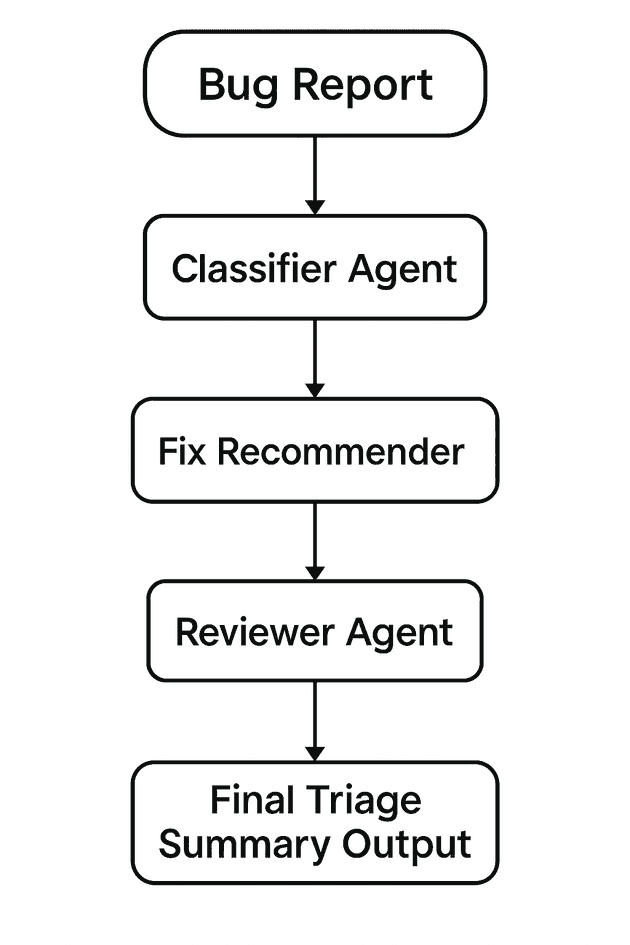Bug triage can be messy. Between classifying incoming issues, identifying affected components, and deciding priority, it's a job that demands speed and accuracy, something AI is surprisingly good at, with the right structure.
In this post, I'll walk you through how I built a multi-agent system using Azure OpenAI to streamline bug triage, using a virtual team of AI agents working together: a Classifier, a Fix Recommender, and a Reviewer.
Why Multi-Agent?
Multi-agent systems are gaining traction because they mirror how real teams operate. Each agent has a specialized role and collaborates to solve a problem. In this setup, agents process bug reports collaboratively, each focusing on a specific task in the triage pipeline.
Key benefits of this approach:
- Specialized Expertise: Each agent can be optimized for its specific task
- Reduced Hallucination: Cross-validation between agents helps catch errors
- Scalable Workflow: Easy to add new agents or modify existing ones
- Consistent Output: Structured JSON responses ensure reliable data flow
- Human-like Process: Mimics real-world team collaboration patterns
Architecture Overview
Getting Started
To implement this system in your own project:
-
Prerequisites
- Azure subscription with OpenAI access
- .NET 8.0 SDK
- GitHub repository for issue tracking
-
Setup Steps
# Clone the template repository git clone https://github.com/xenobiasoft/ai-bug-triage # Install dependencies dotnet restore -
Configuration
- Set up Azure OpenAI endpoints in
appsettings.json - Configure GitHub webhook for automatic bug report processing
- Adjust agent prompts in
Agents/directory
- Set up Azure OpenAI endpoints in
Technical Implementation
The system is built using:
- Azure OpenAI GPT-4o (easily replaced with other models)
- C# .NET 8.0 for orchestration
- ASP.NET Core minimal API for ease of the demo, but an Azure Function would a better fit for production
Here's a simplified example of the agent orchestration:
public class BugTriageOrchestrator
{
private readonly IOpenAIClient _openAIClient;
public async Task<TriageResult> ProcessBugReport(string bugReport)
{
// Step 1: Classification
var classification = await _classifierAgent.Classify(bugReport);
// Step 2: Fix Recommendation
var recommendation = await _fixRecommenderAgent.Recommend(
bugReport,
classification
);
// Step 3: Review
var review = await _reviewerAgent.Review(
bugReport,
classification,
recommendation
);
return new TriageResult(classification, recommendation, review);
}
}The final message structure for the orchestration uses the following JSON structure:
{
"bugReport": "string",
"classification": {
"classification": "string",
"confidence-score": "number",
"justification": "string"
},
"recommendation": {
"affected-areas": ["string"],
"confidence-score": "number",
"justification": "string",
"recommendation": "string"
},
"review": {
"approved": "boolean",
"confidence-score": "number",
"justification": "string"
}
}The Agents
1. Classifier Agent
- Parses incoming bug reports
- Assigns classification (UI, Backend, Performance, etc.)
- Provides a confidence score and rationale
2. Fix Recommender Agent
- Analyzes the issue
- Suggests related code modules or file paths
- Recommends possible root causes or recent related PRs
- Provides a confidence score
3. Reviewer Agent
- Evaluates the previous agents' responses
- Flags hallucinations or inconsistencies
- Provides a confidence score and rationale
Prompts and Coordination
Each agent was given a system prompt:
Classifier Agent:
"You are a senior triage engineer. Read the bug report and classify the bug. Return a JSON object with classification, justification, and confidence-score between 0 and 1."
Fix Recommender Agent:
"Based on this bug report and its classification, suggest likely modules, files, or components. Include a brief justification. Return a JSON object with affected-areas, justification, recommendation, and confidence-score between 0 and 1."
Reviewer Agent:
"Review the bug report, classification, and fix recommendation. Flag vague or hallucinated suggestions. Return a JSON object with approved, justification, and confidence-score."
I used a C# orchestrator to handle the call sequence and capture responses.
Example: Real Bug Report Walkthrough
I tested the agent's orchestration using postman with the following structure:
curl POST /api/bug-triage/
-H "Content-Type: application/json"
-d `{
"description": "The app crashes when uploading a large image from mobile Safari. It works fine in Chrome."
}`Bug Report:
"The app crashes when uploading a large image from mobile Safari. It works fine on Chrome."
Classifier Response:
{
"classification": "Frontend - Image Upload",
"justification": "The app crashes specifically when uploading a large image from mobile Safari, whereas it works fine on Chrome. This implies a compatibility issue between the app and mobile Safari.",
"confidence-score": 0.85
}Fix Recommender Response:
{
"affectedAreas": [
"components/ImageUploader.razor",
"services/UploadService.cs"
],
"justification": "The bug involves uploading, specifically on mobile Safari. These modules are responsible for handling image uploads.",
"recommendation": "Investigate the Mobile Safari compatibility module and the Image upload component to identify the specific code causing the crash on this browser. Test and implement a fix to ensure proper handling of image uploads from mobile Safari.",
"confidence-score": 0.85
}Reviewer Response:
{
"approved": true,
"confidence-score": 0.9,
"justification": "The components and justification are relevant and clearly tied to the browser-specific issue."
}Future Ideas
- GitHub integration: auto-label or comment on new issues
- Embedding search to suggest past similar bugs
- Human-in-the-loop validation before assigning bugs
- Add a "PM Agent" to summarize impact on roadmap
- Implement A/B testing for different prompt strategies
- Add support for multi-language bug reports
- Implement a fourth Fixer agent that creates a pull request with the implemented fix
Final Thoughts
This project gave me a hands-on look at how powerful and practical multi-agent AI systems can be, especially for tasks that mirror real team workflows. It's also a fun playground for prompt engineering and AI tool orchestration.
What other development processes could benefit from a virtual AI team? Let me know your ideas in the comments!
